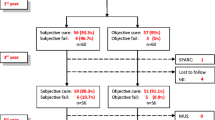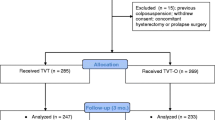Abstract
To report the results obtained with the transobturator sub-urethral tape (TOT) for the surgical treatment of stress urinary incontinence (SUI) after 1 year follow-up. Ninety-three patients diagnosed with SUI or mixed urinary incontinence (MUI) underwent a TOT procedure associated to prolapse surgery, if necessary. Pre-operative quality of life (QoL) was assessed with the Urogenital Distress Inventory Short Form (UDI-6)/Incontinence Impact Questionnaire Short Form (IIQ-7) questionnaires. Surgical and early complications were monitored. A stress test and an urodynamic test if urge incontinence de novo appeared were performed at 1 year follow-up. UDI-6/IIQ-7 questionnaires and SUI symptoms were recorded. Patients’ characteristics, pre-operative quality of life and urodynamic evaluation were similar in the TOT and in the pelvic floor surgery group. From the sample, 15% had post-operative retention and 10% had vaginal erosion. The global rate of objective cure was 97% in both groups. The scores of the QoL questionnaires were worse by 9% and 10% with the procedure, respectively. Patients with urodynamic (MUI) or persistence of SUI symptoms (10%) did not reach a significant improvement, although patients with urge incontinence de novo (10%) did. The TOT procedure is safe and effective. Results showed that the association to pelvic floor surgical techniques did not diminish 1 year later. The stress test outcome assessment can overestimate the results, compared to the QoL assessment. In our report, the MUI did not improve with this surgical approach. Our results highlight the necessary employment of both the objective testing and the patient’s opinion of her symptoms during daily life.
Similar content being viewed by others
Abbreviations
- SUI:
-
stress urinary incontinence
- TVT:
-
tension-free vaginal tape
- TOT:
-
transobturator tape
- QoL:
-
quality of life
- UDI-6:
-
Urogenital Distress Inventory Short Form
- IIQ-7:
-
Incontinence Impact Questionnaire Short Form
- MUI:
-
mixed urinary incontinence
References
Samuelsson EC, Victor FT, Svardsudd KF (2000) Five-year incidence and remission rates of female urinary incontinence in a Swedish population less than 65 years old. Am J Obstet Gynecol 183:568–574
Kuuva N, Nilsson CG (2002) A nationwide analysis of complications associated with the tension-free vaginal tape (TVT) procedure. Acta Obstet Gynecol Scand 81:72–77
Ward KL, Hilton P, UK and Ireland TVT Trial Group (2004) A prospective multicenter randomized trial of tension-free vaginal tape and colposuspension for primary urodynamic stress incontinence: two-year follow-up. Am J Obstet Gynecol 190:324–331
Delorme E (2001) Transobturator urethral suspension: mini-invasive procedure in the treatment of stress urinary incontinence in women. Prog Urol 11:1306–1313
deTayrac R, Deffieux X, Droupy S, Chauveaud-Lambling A, Calvanese-Benamour L, Fernandez H (2004) A prospective randomized trial comparing tension-free vaginal tape and transobturator suburethral tape for surgical treatment of stress urinary incontinence. Am J Obstet Gynecol 190:602–608
Domingo S, Alamá P, Ruiz N, Perales A, Pellicer A (2005) Diagnosis, management and prognosis of vaginal erosion after transobturator suburethral tape procedure using a nonwoven thermally bonded polyproylene mesh. J Urol 173:1627–1630
Uebersax JS, Wyman JF, Shumaker SA, McClish DK, Fantl JA (1995) Short forms to assess life quality and symptom distress for urinary incontinence in women: the Incontinence Impact Questionnaire and the Urogenital Distress Inventory. Continence Program for Women Research Group. Neurourol Urodyn 14:131–139
Fitzpatrick R, Fletcher A, Gore S, Jones D, Spiegelhalter D, Cox D (1992) Quality of life measures in healthcare. I: applications and issues in assessment. BMJ 305:1074–1077
Mattiasson A, Djurhuus JC, Fonda D, Lose G, Nordling J, Stöhrer M (1998) Standardization of outcome studies in patients with lower urinary tract dysfunction: a report on general principles from the Standardisation Committee of the International Continence Society. Neurourol Urodyn 17:249–253
Vassallo BJ, Kleeman SD, Segal JL, Walsh P, Karram MM (2002) Tension-free vaginal tape: a quality-of-life assessment. Obstet Gynecol 100:518–524
FitzGerald MP, Kenton K, Shott S, Brubaker L (2001) Responsiveness of quality of life measurements to change after reconstructive pelvic surgery. Am J Obstet Gynecol 185:20–24
Costa P, Grise P, Droupy S, Monneins DF, Assenmacher C, Ballanger P, Hermieu JF, Delmas V, Boccon-Gibod L, Ortuno C (2004) Surgical treatment of female stress urinary incontinence with a trans-obturator-tape (T.O.T.) Uratape: short term results of a prospective multicentric study. Eur Urol 46:102–106, discussion 106–107
Mellier G, Benayed B, Bretones S, Pasquier JC (2004) Suburethral tape via the obturator route: is the TOT a simplification of the TVT? Int Urogynecol J Pelvic Floor Dysfunct 15:227–232
Wein AJ (2005) Mixed incontinence. J Urol 173:2055–2057
Minaglia S, Ozel B, Klutke C, Ballard C, Klutke J (2004) Bladder injury during transobturator sling. Urology 64:376–377
Krauth JS, Rasoamiaramanana H, Barletta H, Barrier PY, Grisard-Anaf M, Lienhart J, Mermet J, Vautherin R, Frobert JL (2005) Sub-urethral tape treatment of female urinary incontinence—morbidity assessment of the trans-obturator route and a new tape (I-STOP): a multi-centre experiment involving 604 cases. Eur Urol 47:102–106, discussion 106–107
Abouassaly R, Steinberg JR, Lemieux M, Marois C, Gilchrist LI, Bourque JL, Tu Le M, Corcos J (2004) Complications of tension-free vaginal tape surgery: a multi-institutional review. BJU Int 94:110–113
de Leval J (2003) Novel surgical technique for the treatment of female stress urinary incontinence: transobturator vaginal tape inside-out. Eur Urol 44:724–730
Klutke C, Siegel S, Carlin B, Paszkiewicz E, Kirkemo A, Klutke J (2001) Urinary retention after tension-free vaginal tape procedure: incidence and treatment. Urology 58:697–701
Acknowledgments
The authors thank Rosanne Kho Ph.D. (Mayo Clinic, Scottsdale AZ) for her assistance in the preparation of the manuscript.
Author information
Authors and Affiliations
Corresponding author
Rights and permissions
About this article
Cite this article
Domingo, S., Alamá, P., Ruiz, N. et al. Transobturator tape procedure outcome: a clinical and quality of life analysis of a 1-year follow-up. Int Urogynecol J 18, 895–900 (2007). https://doi.org/10.1007/s00192-006-0263-y
Received:
Accepted:
Published:
Issue Date:
DOI: https://doi.org/10.1007/s00192-006-0263-y




